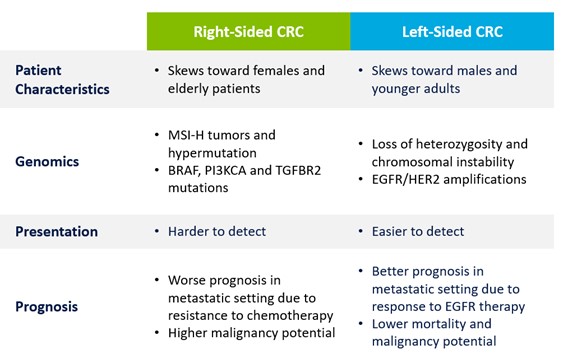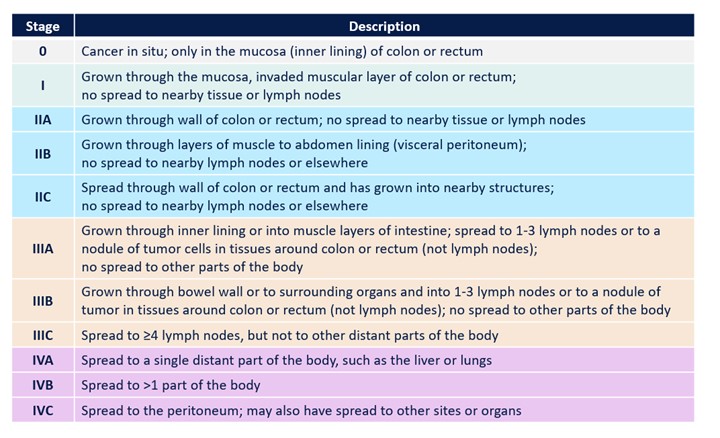COLORECTAL CANCER (CRC)
Exploring dysfunctional pathways, mechanisms, and biomarkers in colorectal
cancer to discover new insights into the progression of the disease.
- Sung H, et al. Global Cancer Statistics 2020: GLOBOCAN Estimates of Incidence and Mortality Worldwide for 36 Cancers in 185 Countries. CA A Cancer Journal for Clinicians. 2021;71(3):209-249.
- National Cancer Institute. Cancer Stat Facts: Colon and Rectum Cancer. https://seer.cancer.gov/statfacts/html/colorect.html. Accessed March 2024.
- Colorectal cancer risk factors. American Cancer Society Web site. https://www.cancer.org/cancer/colon-rectal-cancer/causes-risks-prevention.html. Last revised 2022. Accessed March 2024.
- National Cancer Institute: Colon Cancer Treatment (PDQ®)–Health Professional Version. https://www.cancer.gov/types/colorectal/hp/colon-treatment-pdq Accessed March 2024.
- Moriarity A, et al. Current targeted therapies in the treatment of advanced colorectal cancer: a review. Ther Adv Med Oncol. 2016;8(4):276–293.
- Sung H, et al. CA Cancer J Clin. 2020:209–249.
- Cervantes A, et al. on behalf of the ESMO Guidelines Committee. Ann Oncol. 2023;34:10–32.
- Argilés G, et al. on behalf of the ESMO Guidelines Committee. Ann Oncol. 2020;31:1291–1305.
- Hossain MS, et al. Cancers (Basel). 2022;14:732; 4. Marmol I, et al. Int J Mol Sci. 2017;18:197; 5. NCCN. Clinical Practice Guidelines in Oncology. Version 1. 2023
- Amersi F, Agustin M, Ko CY. Colorectal cancer: epidemiology, risk factors, and health services. Clin Colon Rectal Surg. 2005;18(3):133-140.
- Marmol I, et al. Int J Mol Sci. 2017;18:197.
- Testa U, et al. Biomedicines. 2020;8:414.
- Puccini A, et al. Curr Colorectal Cancer Rep. 2018;14:152–158.
- Huang D, et al. Cancer and Metastasis Reviews. 2018;37:173–187.
- Gatalica Z, et al. Fam Cancer. 2016;15:405–12.
- ASCRS. CRC treatment guidelines. 2022. Available at: https://journals.lww.com/dcrjournal/Fulltext/2022/02000/The_American_Society_of_Colon_and_Rectal_Surgeons.7.aspx.
- American Joint Committee on Cancer. Colon and Rectum. Amin MB, Edge S, Greene F, Byrd DR, Brookland RK, et al, eds. AJCC Cancer Staging Manual. 8th ed. New York, NY: Springer; 2016.
- NCCN. Clinical Practice Guidelines in Oncology: Colon Cancer. Version 1.2023; 2. Hossain MS, et al. Cancers (Basel). 2022;14:732; 3. Cervantes A, et al. Ann Oncol. 2023;34:10–32.
- CRC Efficacy Accessed March 2024.
- Liver Metastatis Accessed March 2024.
- CRC Management Unmet needs Accessed March 2024.
- Genomic profiling Accessed March 2024.
- Predictive biomarkers Accessed March 2024.
- Precision medicine Accessed March 2024.
- Liquid biopsy Accessed March 2024.
- Lin A, Zhang J, Luo P. Crosstalk Between the MSI Status and Tumor Microenvironment in Colorectal Cancer. Front Immunol. 2020 Aug 12;11:2039. doi: 10.3389/fimmu.2020.02039. PMID: 32903444; PMCID: PMC7435056.
- Deng T, Duan J, Bai M, Zhang L, Li H, Liu R, Ning T, Ge S, Wang X, Yang Y, Ji Z, Wang F, Ba Y. Third-line treatment patterns and clinical outcomes for metastatic colorectal cancer: a retrospective real-world study. Ther Adv Chronic Dis. 2023 Sep 13;14:20406223231197311. doi: 10.1177/20406223231197311. PMID: 37720594; PMCID: PMC10501067.






